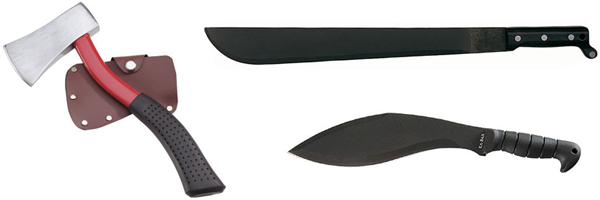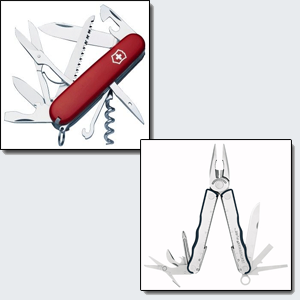Now THAT’s a (Survival) Knife; Varieties & Comparisons
No one would argue that having the right tool for the job is not one of the cornerstones of preparedness. And, while improvisation is another vital trait for the prepared individual, the use of tools is one of the hallmarks of humanity. With that in mind, we’re going to look at the Knife… one of man’s earliest tools and how it fits into modern survival and preparedness scenarios.
The Prehistoric & Historic Knife
Some sort of sharp edged implemented used for cutting has been with us for at least 2.5 million years. That’s LONG before the incidental (1.9 million years ago) or controlled (400,000 years ago) use of fire. With our relatively weak teeth and non-existent claws, the knife was a major leap in our ability to shape, manipulate and survive our environment.
The regulation of ownership of a knife is almost entirely a modern concept. With the exception of some particularly restrictive regimes, it’s nearly impossible to find an era of the pre-modern age where a person would conceivably be without this vital piece of equipment. The basic, day to day functions of life; processing food/resources, grooming, hunting, tool making, shelter building, defense and arts/crafts, were all but impossible without a knife of some sort.
Why A Knife?
Along with fire making, a knife or similar implement is the backbone of survival scenario. It is the “leverage” you can use to make other tools, improvise shelter and process resources. Without such an implement ever other task will become exponentially harder. People that have found themselves in such situations quickly realize that if they don’t have such a tool, they have to improvise one quickly (broken glass/stone, metal debris, etc).
What To Look For In A Knife
Although we are going to be looking at several types of implements with widely different attributes, there are some general traits and qualities they should share and that you should look for when choosing your tool.
Composition: There are more types of metal (and non-metals, for that matter) available today than ever before. These range from cheap/utilitarian to exotic/impractical to artistic/cosmetic. Without getting into too deep of a debate, I’m going out on a limb here and saying that a middle-ground choice between availability, cost and quality is the ubiquitous “1095” Steel. If price is no option or you have “special needs”, there are certainly no limit of other materials, but this is a good starting point if you don’t currently own an implement or are unfamiliar with the various materials available. A knife of this material is also a good training/starter knife for the user to practice realistic techniques without fear of damaging or losing a more valuable implement.
Design: As knives have become less and less prevalent in “civilized” society, they have become objects of symbolism and art to many people. Any knife catalogue or convention booth will reveal no limit of fanciful or creative flourish in design. While I do appreciate the beauty of an artistically crafted knife, in the case of practicality these features can work against you. Flourishes can weaken the tool, get in the way and even make the item impractical or dangerous. As a general rule when looking for a survival tool, try to choose an unadorned, simple version.
Classifications of Knives & Knife-Tools
There are three, very broad categories we’ll be looking at here. For expediency, I’ve categorized these by size as well as utility; Small Utility Knife/Tools, Mid-Sized Knives and Large Knife/Tools. The trade-offs generally speaking are weight, bulk, legality and finesse versus durability.
Small Utility Knife/Tools
These include multi-tools, Swiss Army knives and Pocket knives. The primary advantage here is that these are very cheap, easy to add to any kit and can incorporate several types of tools along with their primary role as cutting implements.
The drawback is that they tend to be less durable and unable to handle heavier tasks. They are an excellent compliment to a larger knife, though and can greatly increase the types of tasks you can perform. Because of their size, they can be carried about with little inconvenience and relatively little consideration for the social impacts (with the notable exceptions of Air Ports & Government buildings).
No car, home, backpack or boat should be without at least one knife of this category. Decide for yourself which of the most common features suits your survival scenario and then choose the small knife that suits your needs. For most people this comes down to either a Swiss Army style knife or a Multi-Tool style knife. Reputable dealers include Victorinox, Gerber, Leatherman and Tool Logic.
Mid-Sized Knives
These are traditionally the category of knives that people consider survival knives. As a whole, they are heavier, single-blade/tool affairs ranging in 3.5″ to 12″. Some examples include the Bowie knife, Ka-Bar and various “hunting” knives. Although, fixed blades are preferred by many, folding blades are not uncommon.
Mid-sized knives represent a shift from the precise functionality of smaller, multi-tools to a user-skill based implementation. That is to say, the user is the real feature behind tools of this category. With proper training, a knife of this category becomes a truly versatile implement. Among survivalists, this category is often the most popular.
 |
Do NOT be seduced by “Rambo” knives with intimidating looking flourishes and seemingly indispensible secret compartments. You are looking for durable materials; namely environment resistant blade & grip. Field serviceable design; few/no moving parts, sharpen-able under primitive settings. Rugged construction; thick blade, strong/extended tang, no loose parts.
In the words of one knife manufacturer, “It must be long enough to use as a weapon, sharp enough to use as a razor, wide enough to use as a paddle, and heavy enough to use as a hatchet.” That pretty must embodies the expectations of this demanding category of knives.
Unfortunately, knives of this category are much more restricted by many local/federal agencies and often cannot be practically carried under all circumstances. Additionally, their increased size/weight may make them impractical for smaller kits and packs.
Large Knife/Tools
This category starts to transcend the narrow definition of knife. These items are often thought of tools in the sense of a garden or shop implement. They are generally found in larger vehicles, expeditions and special settings. However, most experts agree that in their respective roles and with the proper training, they can quickly turn a disaster into a manageable survival situation.
Some classic examples of the large utility class of “knives” are the Machete, Hand Axe, Kukri/Bolo and Trench or Folding Shovel.
 |
Machetes include a wide variety of long blades that resemble short swords. They are common in tropical and near-tropical settings, as well as among land-clearing & agricultural roles. They excel at processing the lighter & fast growing plant materials of these settings and can provide almost all the needs of individuals in these environments. Common drawbacks include: poor quality or mass produced machetes, severe carrying/ownership restrictions and lack of utility in other environments.
The Hand Axe is the temperate climate counterpart of the Machete. Its heavy blade, if kept sharp, is perfect for processing the heavier materials of more mid-latitude to northerly climes. Some survival models often include a sharpening stone or smaller knife in the stock, but if you have to choose between a solid, simple hand axe and a flimsier utility axe, I’m strongly inclined to the former.
Kukri & Bolos might be unfamiliar to many people from western cultures, but they are very common in India and Asia. They are basically large implements with a heavier, curved (slight to quite pronounced) blade with weight focused towards the end of the implement. These features are excellent for transferring the force of a blow onto the target surface. If handled properly, they are an excellent compromise between the Machete and the Hand Axe. Like the Machete, however, they suffer a bit of a stigma and high-quality ones may be harder to come by.
Various Disclaimers
The regulations and laws regarding the the purchase, shipping, ownership and carrying of knives vary GREATLY from location to location. In addition, even in areas where there are no restrictions, the possession of some of these tools may agitate private citizens as well as law enforcement. Always be sure to consult the local situation. Regardless of local regulations, NEVER carry or brandish your tools in an irresponsible manner.
Additional Research
 |

Leave a Reply